Neutrion Difference Between Bison and Beef
Diet
The BisonBasics Nutritional Comparison Chart
At Bisonbasics.com over 65% of our recipe inquiries are for ways to prepare ground bison. This includes burgers, meatballs, meatloaf, chili and the like. The following nautical chart compares uncooked grass-fed ground bison to ground beef, turkey, pork, and chicken. All data equally per the USDA National Nutrient Database for Standard Reference.

Bison Basics Nutritional Comparison Nautical chart for Cooked Meat
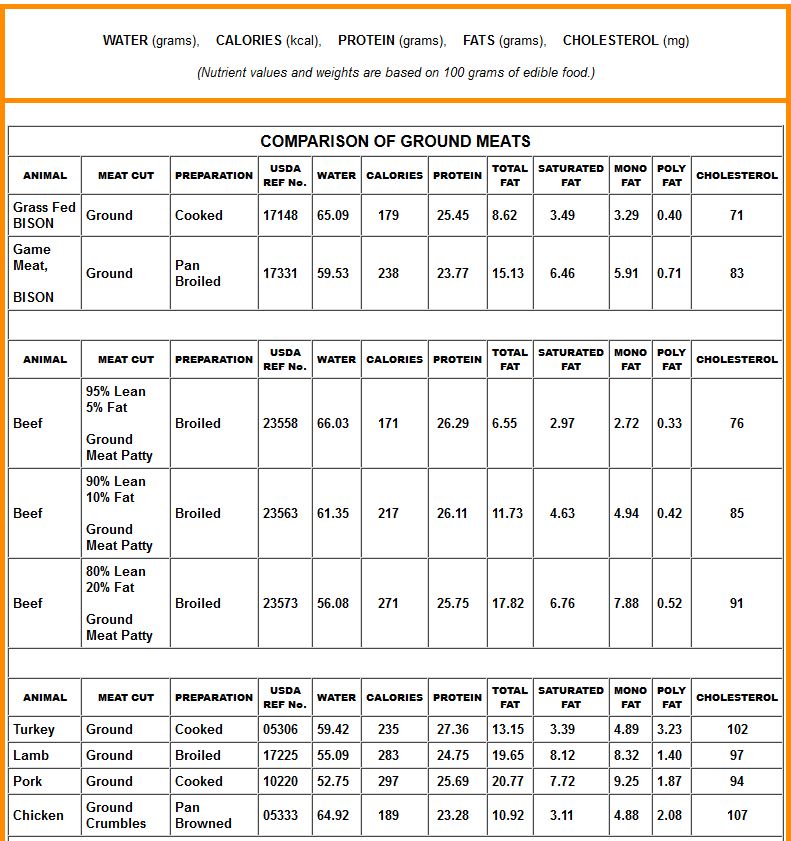
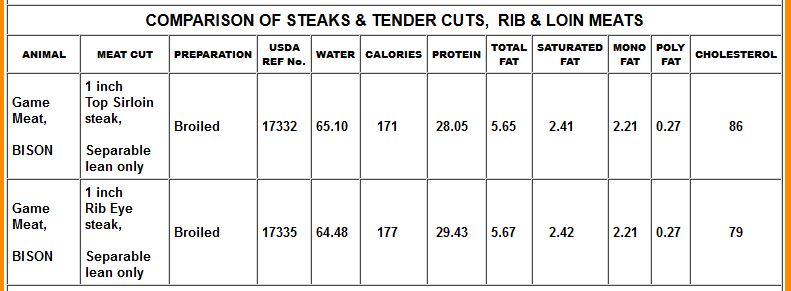
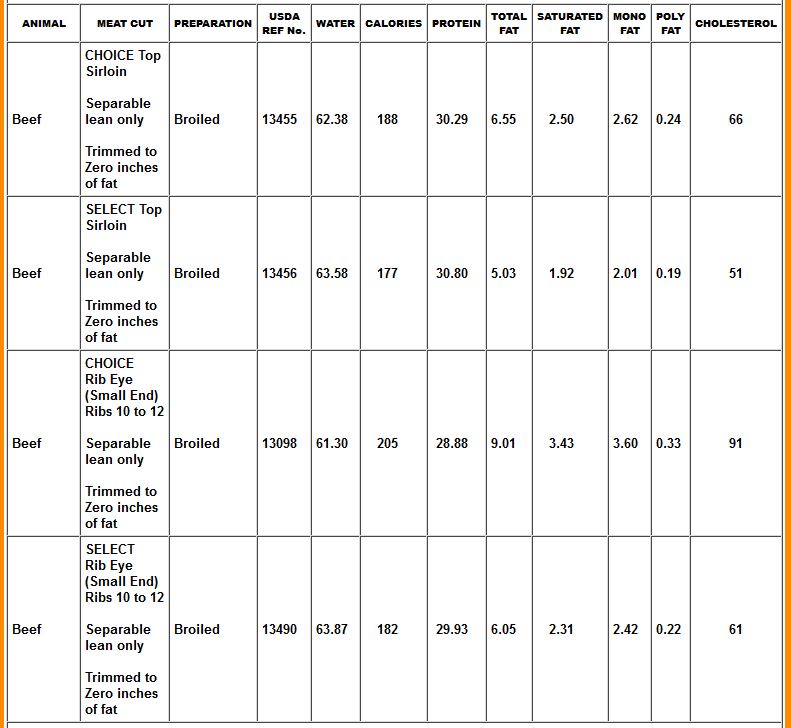
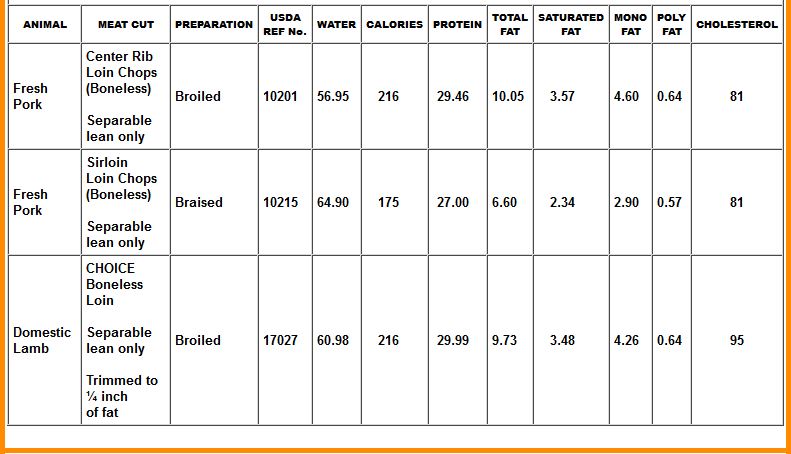
Bison Nutrient Values Can, And Practise, Differ
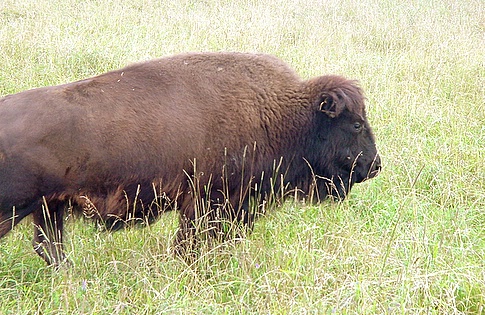
To be of specific value to you lot, the consumer, nutritional testing is all-time done at the individual subcontract level. For full general comparative purposes USDA data is adequate, but information technology cannot be expected to accurately employ to the same cut of bison from different sources. In numerous situations, nutrient values for meat from unlike bison farms differs from USDA Nutrient Database information.
Nutrient measurement, like all fields of measurement, uses instruments and techniques that are less than perfect. Observation and transcription errors do occur even in the hands of the near competent researchers, but this is the least of our concerns when information technology comes to bison meat nutrient measurements. Since bison are not raised in strictly controlled feeding environments, obtaining completely accurate nutrient information can exist a claiming. At times inconsistencies may only exist at a micro-nutrient level. In other instances a macro nutrient, such as fatty, which can vary from cut to cutting, will, depending on feeding practices, as well vary from bison to bison.
There are a number of reasons why this is the case. Outset, like all farm animals, bison are a product of their own immediate environment. For bison that environs is primarily pasture. What bison swallow while being pastured, which tin can differ from subcontract to farm, is a determinant when information technology comes to nutrient values. Weather conditions, herd rotation, pasture management and soil treatments (if applicative) will all affect pasture quality, and ultimately the nutritional profile for the meat.
Nutrient values in bison meat can also be affected by supplemental vitamin and mineral feeding which is subcontract specific. The quality and types of hay consumed by bison when fresh pasture is non available is another factor, and supplemental grain feeding and finishing, where expert, is notwithstanding another determinant.
Besides feeding variables, food values can exist affected by breeding and genetics, historic period and sexual practice, and even the fourth dimension of year when a bison is harvested.
Testing conducted at farms utilizing consistent feeding protocols is the only way to be more certain of nutrient values for the bison meat yous swallow. Unfortunately, the toll benefit of conducting such testing is prohibitive.
For bison, the nutritional data used almost often is from the USDA's National Nutrient Database for Standard Reference. But because of aforementioned factors, the data on bison is best considered approximate. Nevertheless, BisonBasics maintains that when the most appropriate USDA data is chosen, the result is a better informed consumer. Information technology is not clear that the aforementioned merits tin can be fabricated when consumer stance is based on limited, less articulate information made bachelor through some bison association and chapter member websites.
Further Examination Of The Problems With Commonly Bachelor Data
What is widely bachelor and used by many farms and regional associations in the promotion and marketing of bison is the National Bison Association's (NBA) Nutritional Comparison Chart. The Canadian Bison Association's 'Nutrient Composition' chart varies only slightly--more on that later.
A large office of the problem with charting nutritional data is due to the lack of comprehensive and upwardly-to-date data care of the USDA, the only national public service arrangement to research and provide such data. Unfortunately as far as research data is concerned, bison is sadly defective when compared to beef. In that location are 712 items listed under USDA's 'beef' heading, simply simply 15 for 'bison'. The bison industry has of course grown considerably over the past decade and become more than profitable. But not to a point where officials can be convinced through lobbying efforts, which are largely unaffordable, that more enquiry data related to bison nutrition is warranted. It will continue to be a slow process.
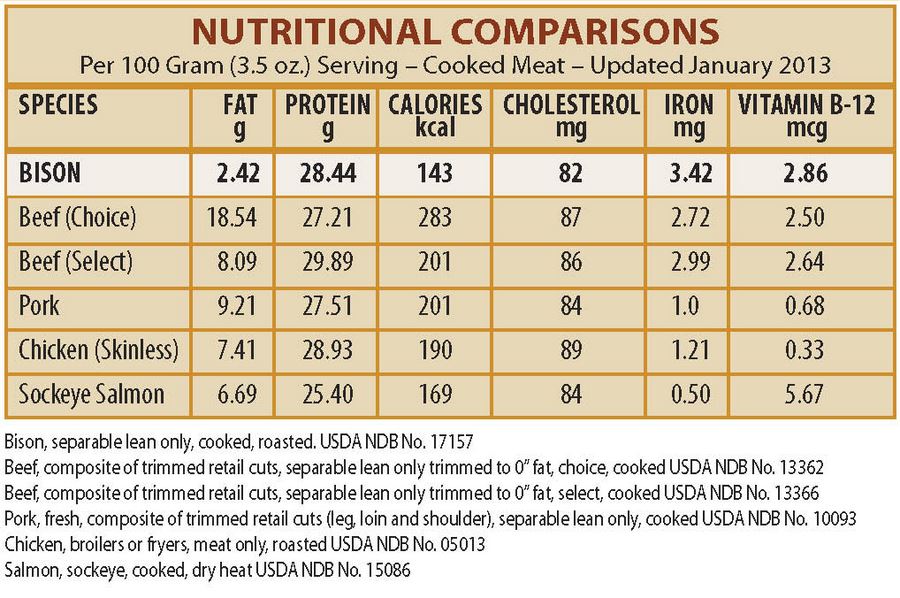
USDA 'Roasted' Bison - Non The Best Choice For Comparative Purposes
Vii of the fifteen items listed past the USDA chronicle to cooked bison. The only cooked bison particular included in the NBA Nutritional Comparisons chart is: Game meat, bison, separable lean only, cooked, roasted', NDB # 17157.
The problem with this data is that it is not clear what it represents. Do the numbers represent blended data for several roasts from different parts of a single bison? Or is this composite information for the verbal aforementioned cut from numerous bison; and if then, how many bison equal 'numerous'? Or could all the data be based on merely one unmarried bison roast? It'due south not at all articulate.
One reason this information was called by the NBA may be the fact that item #17157 has the lowest fat in the unabridged cooked bison category---ii.42 gm. full fatty per 100 grams of cooked meat. Some other reason…… this category of bison meat (17157) has the lowest caloric value (143 kcal) of the six foods listed on the NBA nautical chart. And thirdly, this choice also has the lowest caloric value for all the cooked bison items listed on the USDA site.
Although the numbers look practiced, this unmarried line of data for bison is non much utilize to the consumer. It conspicuously represents a set of nutritional values for non-specific bison cuts prepared using a cooking procedure that the majority of bison consumers don't employ - roasting!
Other USDA data equally information technology relates to cooked bison is available in the BisonBasics Appendix 'A' chart. Fortunately the remaining half dozen items in the cooked bison meat category are more than specific and/or relevant to consumer needs than detail #17157.
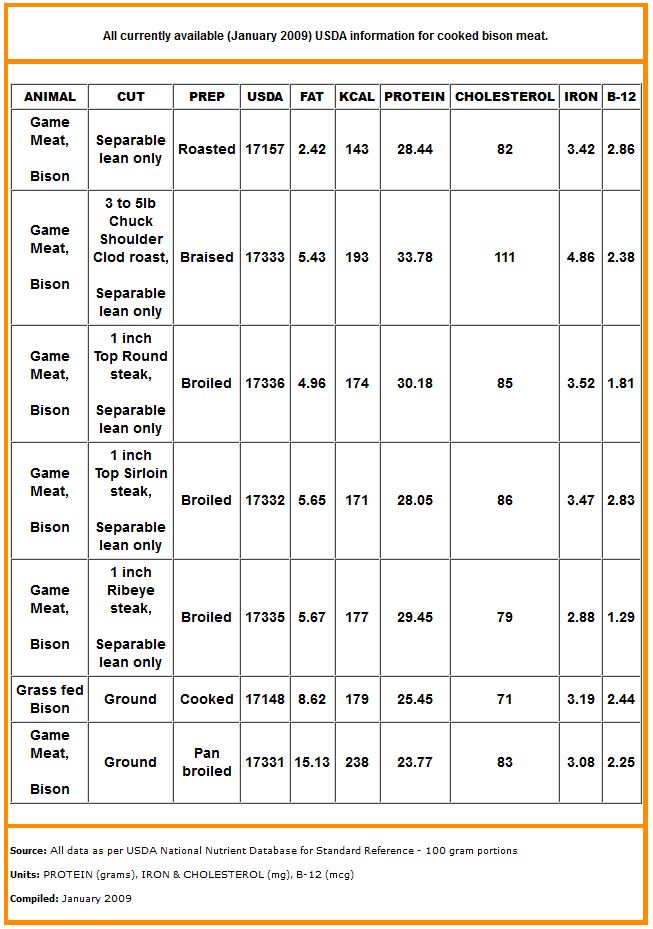
Other Bug With The NBA's Nutritional Comparing Chart
Both the beef choice item (13362) and the beef select particular (13365) are based on a 'composite of trimmed retail cuts, separable lean just, trimmed to 0" fatty, cooked'. (Delight note the NBA site appears to utilize the 13362 lawmaking which is not correct for the description provided. 13365 is the correct data code.) A 'composite of trimmed retail cuts' can include only about any cut from neck to tail. Many may notice such data also general to be of any relevant or comparative value.
The situation is not that much different for pork which is not listed in the form of a specific comparative cutting either. The information charted is for 'Pork, fresh, blended of trimmed retail cuts, (leg, loin, shoulder) separable lean only, cooked'. Again, this data is as well full general to be of much value.
Although comparing food data betwixt like cuts of bison, beef, and pork is possible, poultry not having the aforementioned beefcake is a bit of a comparative stretch. Granted nutrient data for chicken tin can exist of some value. Simply the NBA listing is for skinless 'meat only roasted' broilers or fryers (05013). The question is, 'How many people actually set up and eat skinless meat simply chicken?'. For comparative data to be relevant, perhaps the Nutritional Comparisons chart should have included information on chicken that people are more than likely to swallow. This could include skin-on fried chicken, rotisserie chicken, or fifty-fifty fast food craven similar KFC's or Popeye's. Meliorate still; why not just compare ground bison to basis craven or turkey?
Sockeye Salmon Gets Unfair Handling
At the bottom of the NBA'due south Nutritional Comparisons chart is Sockeye Salmon. The USDA reference is 'Salmon, sockeye, cooked, dry heat' (15086). What is most noteworthy here is the figure listed for fat content, 10.97 grams. According to the NBA's chart, sockeye salmon has 4 ½ times more than fat than bison. And information technology is true, salmon does take 4 ½ times more total fatty than bison. Just by not explaining the fact that sockeye salmon contains more often than not very healthy fats, consumers not in know are mislead into believing that 4 ½ times more fatty is simply plain bad news.
Co-ordinate to the USDA, the sockeye salmon cited by the NBA contains: ane.97 grams saturated fat, 5.29 grams monounsaturated fat, and 2.409 grams polyunsaturated fat. The bison has: .91 grams saturated fat, .95 grams monounsaturated fat, and .24 grams polyunsaturated fat.
When compared to the sockeye salmon portion, the fat values for the bison sample are of limited health value. The amount of total fat independent in sockeye salmon is very salubrious in that nearly 75% of it is completely unsaturated. Of that unsaturated portion, the polyunsaturates are 10 times college than what can be found in the bison sample.
Polyunsaturated fats include fat acids from the Omega-6 and the Omega-3 families. Both are necessary for good health. But sometimes our diets, beingness overly grain/cereal based, can be also loftier in Omega-vi. Aye, eating 100% grass-fed bison can aid maintain a healthy Omega 6/Omega 3 contour. Only the health benefits derived from consuming fatty fish high in Omega-3s, every bit is the case with sockeye salmon, should not be ignored or relegated to the bottom of any nutritional comparing nautical chart.
Canadian Bison Association's Food Composition Chart…..Not An Improvement
Unfortunately the Canadian Bison Association's (CBA) 'Nutrient Composition' Chart fares no amend than the NBA's nutritional chart. In fact, in comparison, the CBA nautical chart would have to exist considered even less informative. 2 categories of analysis, Vitamin B-12, and more importantly 'protein content' are not included for any of the foods. Data provided on the CBA website is based on information from the dated 2001 Canadian Nutrient File (CNF)
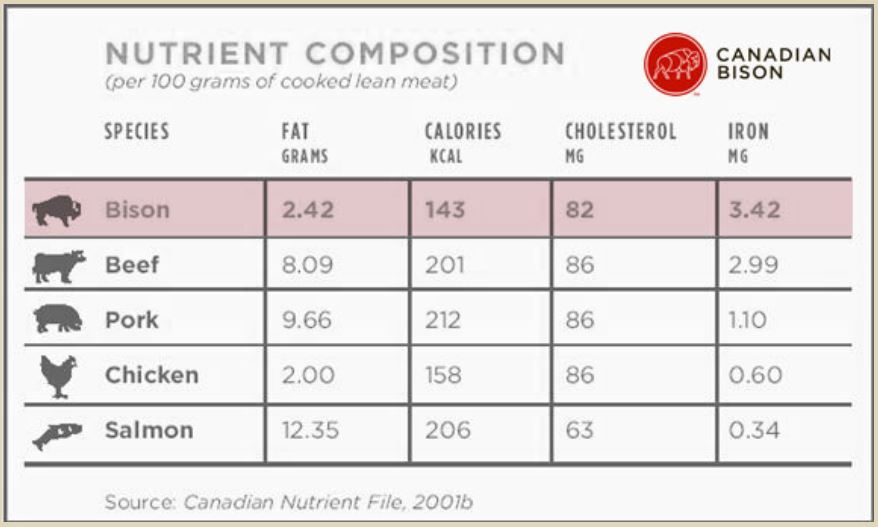
To the credit of the NBA, that organization has used nutrient file identifiers in its analysis, while the CBA has chosen non to. No affair though. The information for bison and pork is identical. The data for beefiness (select) is too the aforementioned; although differences in the Canadian beef grading organisation suggests the nutritional information listed on the Canadian chart should be slightly different.
The CBA chicken data is different from the NBA's and appears to be for roasted skinless chicken breast meat. Although not exact, the closest data seems to be associated with CNF item #892. Still, as is the case with the NBA, in that location are craven products more than common to the Canadian palate that would have been more than appropriate than the skinless chicken item chosen.
The salmon listed at the lesser of the Canadian Bison Association's 'Nutrient Composition' chart is 'Salmon-Atlantic farmed, baked or broiled-CNF #3183. It too, like sockeye salmon, has an impressive nutritional profile. Unfortunately, farmed salmon is surrounded in controversy. Industrially farmed salmon has been known to spread sea lice to wild stocks and contaminate littoral environments. Co-ordinate to some critics, it can exist unhealthy to consume. Organically farmed salmon, where obtainable, seems to be a more than adequate choice. Better still, cull sockeye salmon which is never farmed and widely available in cans.
Ontario's Cape Mentum Bison Provides Subcontract Specific Nutrient Data
Grass-fed bison will usually have an Omega half-dozen to Omega three ratio of 4:1 or less when finished on fresh grass. Today's cheap nutritional testing procedures tin can verify this and supply other of import 'farm specific' nutrient data. Although this type of nutritional testing for bison meat is not all that common, we did notice that Cape CHIN BISON due north of Toronto does provide data for its ground bison. Cape Chin Bison Farm is 1 of the very few producers, if non the only one, that provide farm specific nutrient data for its 100% grass-fed ground bison. This sound business practice benefits both the farmer and the consumer. Let'south hope more bison farms prefer this practice in future.
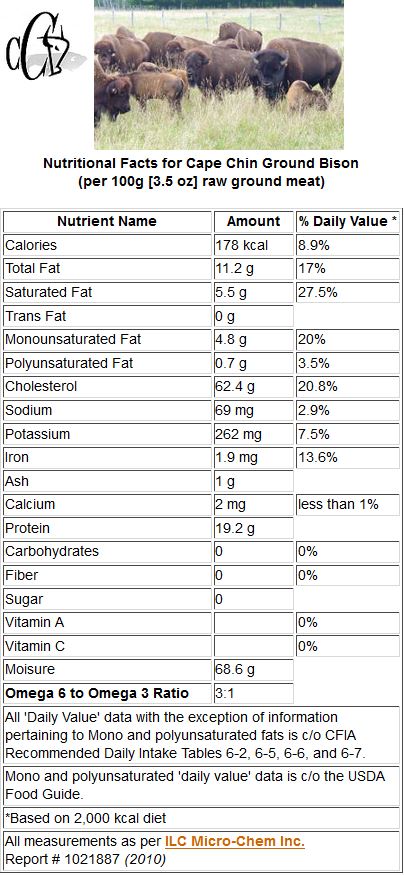
Dietary Reference Intake
It's as well important to know the Dietary Reference Intake (DRIs) for bison meat, or what are more usually know as the Recommended Dietary Allowances (RDAs). We have created a nautical chart that summarizes the USDA data for the percentage of recommended daily intake (for adults over the age of 14) in 100g of edible Bison Ribeye Steak (NDB #17335) in order to show to what extent the various nutritional components run across your daily intake requirements.

Data based on USDA sources (Food and Diet Board, Institute of Medicine, National Academies) and The Omega Nutrition (Simopoulos and Robinson), Compiled: January 2009.
Annotation: This information should be treated equally a general guideline merely. Differences in nutritional requirements practice be between men and women and can exist influenced by such factors as age, concrete activity/caloric requirements, and certain health atmospheric condition. Understanding one's personal nutritional requirements are all-time done in consultation with a qualified dietition or nutritional skillful.
Source: https://www.bisonbasics.com/nutrition.html

0 Response to "Neutrion Difference Between Bison and Beef"
Post a Comment